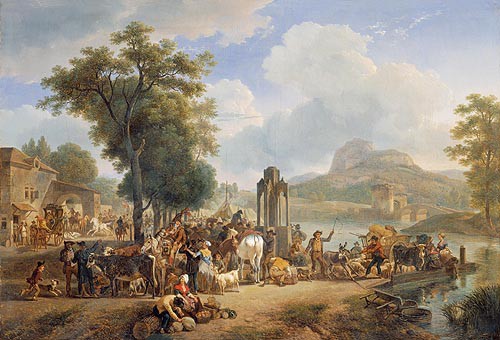Of Flemish origin, Jean-Louis Demarne made his name as an illustrator of the rustic mores of his day, concentrating on the daily life of the working classes from the Revolution to the Empire period. Taking his inspiration from the Dutch School, his exceedingly prolific output is characterised by picturesque compositions, where the artist gives himself free-range in the evocation of the colours and shades of the life of countryfolk. Licensed in 1783 by the Académie royale as a “painter of animal genre scenes”, Demarne made his debut at the Salon in the same year and was to exhibit there until 1827. Working by theme, he produced “series” of paintings, such as, roads, fairs, seascapes, canals, but always avoiding the monotony of repetition by an infinitely varying his canvasses in their composition and details. Roads and canals form perspectives which draw the eye to the horizon, and around these Demarne places the same elements but in different combinations: inns, mills, carriages, carts, transports being loaded or unloaded, people going about their daily business, and animals such as horses, mules, cows, sheep, goats, geese and the ubiquitous dog, the standard feature in all the pasture, trough, market, beach and return from fishing scenes. In the fair and village fête scenes, when the crowds thicken, Demarne's anecdotal skill comes to the fore. Another commonly occuring feature is the presence of small gothic monuments in many of his pictures, a feature indicative of the incipient Romantic style borrowed from troubadour painting.
Demarne was hugely successful during the Empire period, both amongst aristocratic and middle class. At the Salon of 1804,the empress Josephine acquired a painting entitled “Un charlatan de village”, and the inventory made after her death in 1814 of the collections held at Malmaison mention three paintings by Demarne, a “Village fair with a Gothic tomb”, clearly very close to that presented here, a “Corpus Christi procession in a village”, both exhibited at the Salon of 1808, and a “View of a main road”. Yet further variations of the 'road' theme were present in the collection of Lucien Bonaparte from 1804 on, and in that of the emperor Alexander in 1806 and in the state acquisitions at the Salon of 1814.
Karine Huguenaud (tr. P.H.)
November 2004
Fair by a river
Artist(s) : DEMARNE Jean-Louis


